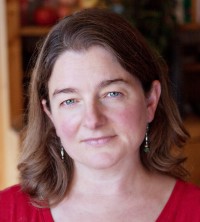A lapsed Catholic’s unexpected devotion
Searching for the Mary statue from her childhood, Sonja Livingston found much more.
When essayist Sonja Livingston finds herself returning to her childhood Catholic parish, devotion takes her by surprise. She has a craving that she cannot articulate, and it appears regularly and with enough insistence that she ends up in the pews again and again.
The new parish and her childhood parish are housed in the same building, but they are not the same. The churches have undergone consolidation. The name has changed. The priest and the people are different and speak different languages. Most significantly for her, the statues are different.
One statue that remained in her memory through the years was a statue of Mary, which is no longer there. Throughout the book, even as she goes on several other “expeditions into devotion,” Livingston returns again and again to her search for that particular statue, for which there can be no substitution. Searching for that Mary statue takes her into the strange world of Catholic congregational consolidation. When one parish joins another parish, where do all the religious items go?
Her other spiritual adventures include a trip to New Orleans to visit a mobile confessional. She visits Galway, Ireland, for the Feast of Corpus Christi. In a strange and beautiful essay called “The Heart Is a First-Class Relic,” she recounts going with other pilgrims to Quebec to visit the heart of Brother André, a 20th-century monk.
Experience plays one part in Livingston’s narrative. The other part—and for me the part that makes this book an exciting addition to the literature of devotion—is Livingston’s search for a viable religious language.
Writers can be especially persnickety about [language] and keep running tallies of objectionable words in their heads. For years I simply lumped God in with words like cerulean and staccato and moved on. The trouble began when I returned to Corpus Christi. What on earth am I doing? I’d ask anyone who’d listen, but stumbled even as I tried to formulate the question. Clearly, I needed to explore language itself—How was I to delve into the matter when I couldn’t even bring myself to use the word God?
Livingston contrasts her search for religious language with the words and actions of her 90-year-old friend Mary, who has no trouble claiming and using the language of faith. In the 1950s, for example, when the man who became her husband asked her to marry him, Mary responded that she would have to check with St. Joseph before giving an answer. Mary’s faith in divine communication has apparently never wavered. When she learns about Livingston’s search for the missing statue, Mary makes it very clear that the search will not be successful until Livingston prays to St. Anthony, the patron saint of lost things.
Livingston treats her friend’s ardent devotion with deep respect and a significant amount of mystery. She affords the same kind of respect (and mystery) to her own search—and to her conclusion that no abstract religious language is likely to satisfy her.
But the language she finds instead is one that renders the sensual nature of faith. Writing about her memory of serving as an altar girl during communion, for example, she recalls:
The rhythm and splendor of the Mass seeped in through my eyes and ears and even my nose until they imprinted onto each of my cells. The weight of the globed cruets in my palms; the gleam of the polished chalice; the motion of the paten going back and forth in my hands as I stood beside the priest, extending the brass plate under the chins of those who still received by mouth in case any particle should fall. . . . When else did we bow to something larger than ourselves? Where else had I seen faces so open and solemn?
Here communion brings together a multitude of aspects of human experience—touch, taste, sight, sound, smell, emotion, and surrender.
This kind of rich experience does not leave a child easily, but it does become harder to explain as the child grows up. Is Livingston’s return to the communion table later in life a form of nostalgia? Or is there a something new there for her? She does not aim for certainty. Instead she eventually finds her way from being the one who “sits at the back holding conversations with ghosts” to one joining the strange parade of humanity toward the priest at the front. “For a moment, we all flare—break right open and shimmer—as he sets the Body into open hands.”
Livingston’s search for the statue and its “truest shade of blue I’ve ever seen” guides the interconnected essays until the very end. It is a search for the place where the material meets the immaterial, where the divine mixes with human emotion and experience. In other words, it is a search for the incarnation. Livingston’s invitation to her expeditions is pitch perfect. She is skilled at laughing at herself, gently poking fun at the tradition that she’s returning to with new eyes, and drawing us toward the mystery that ultimately cannot be spoken.







